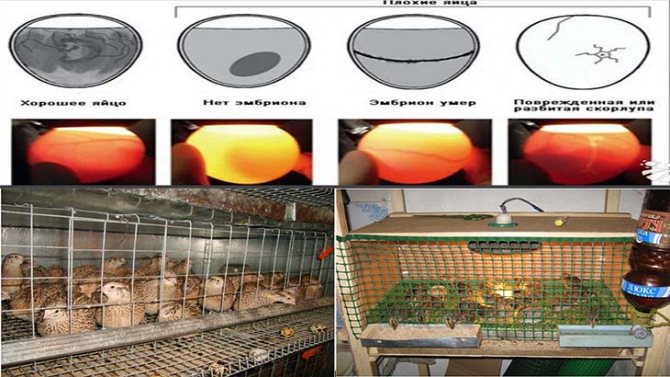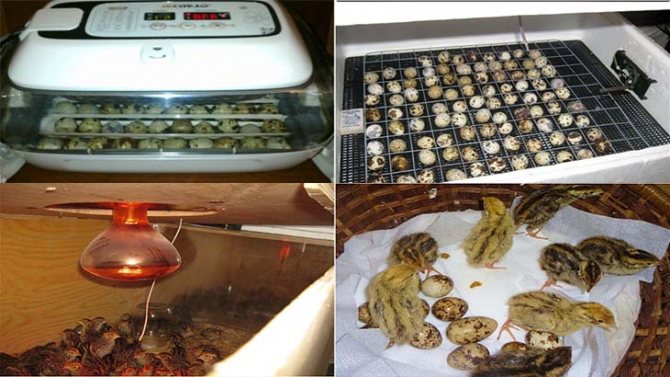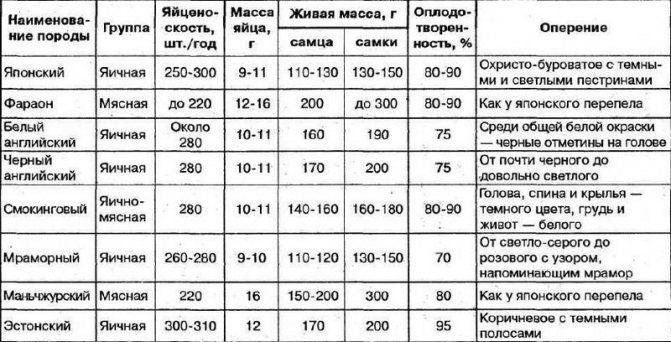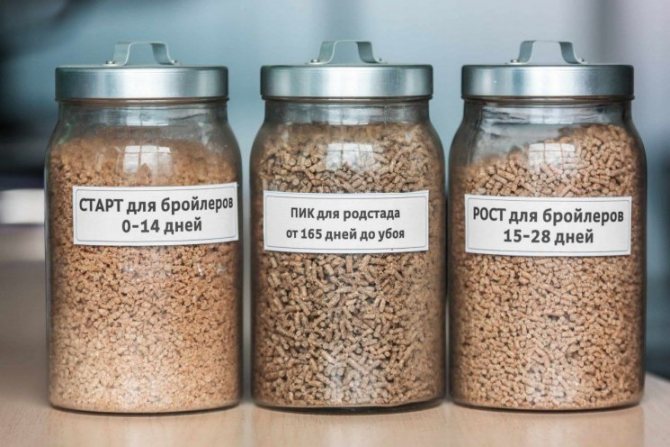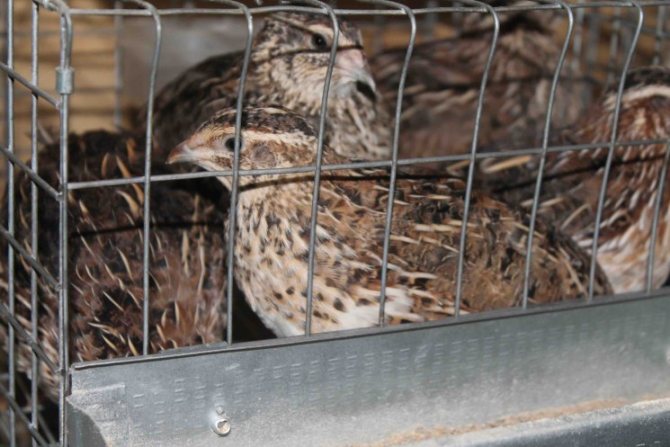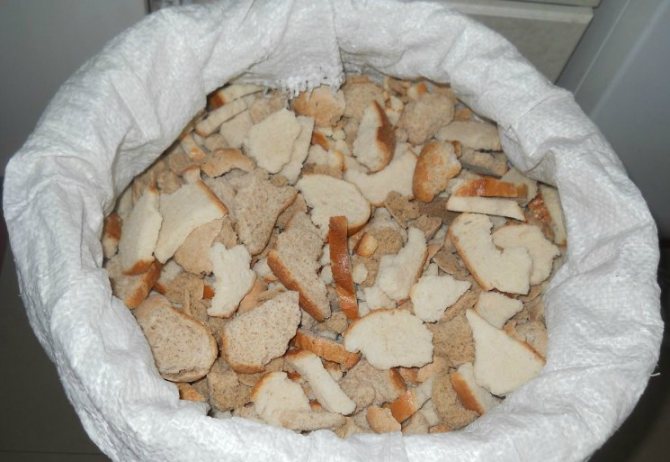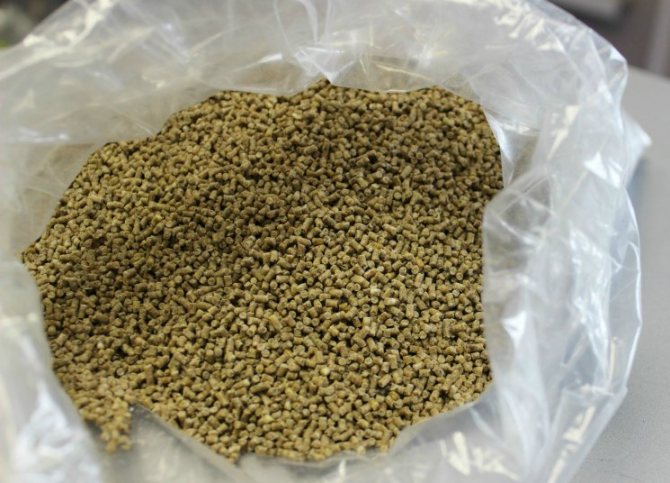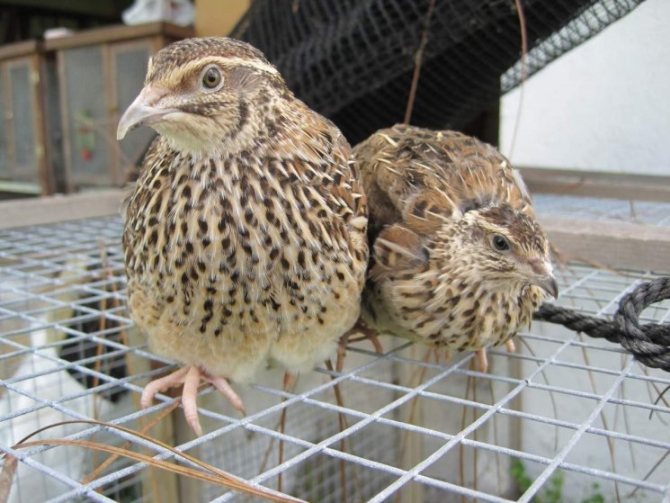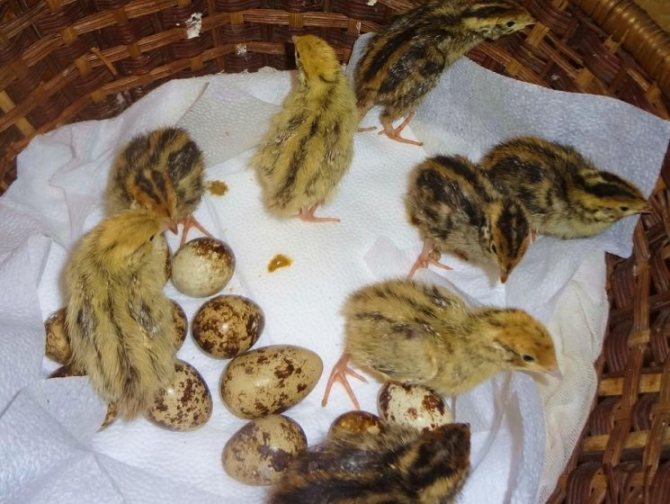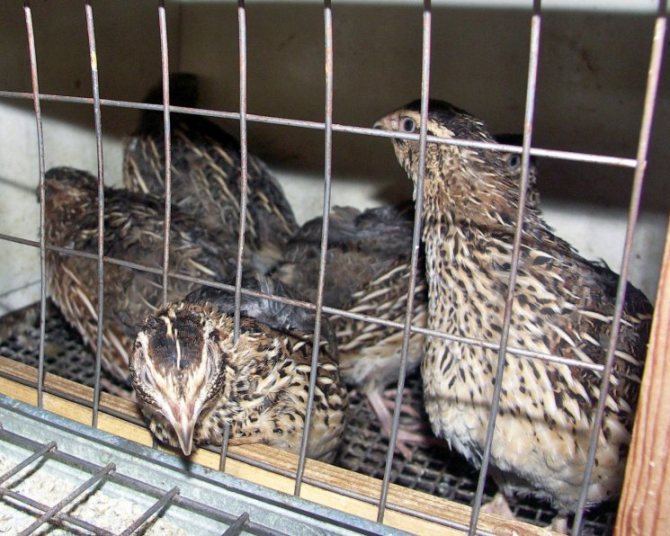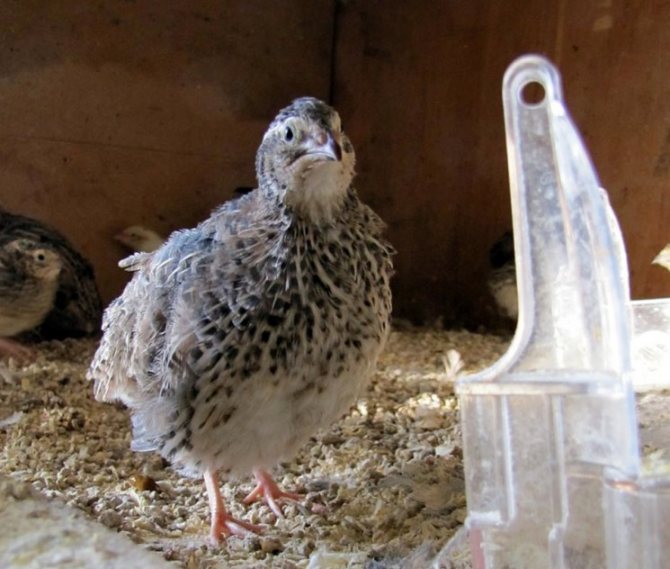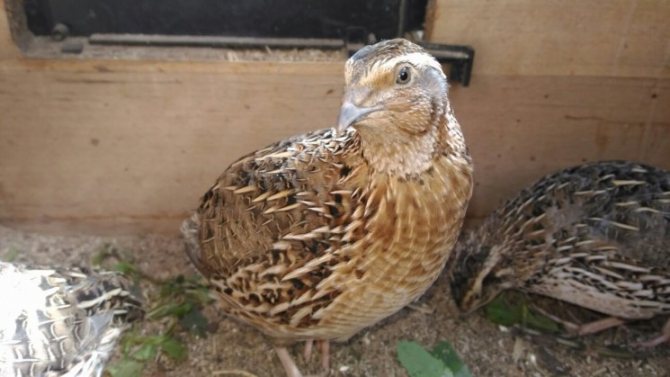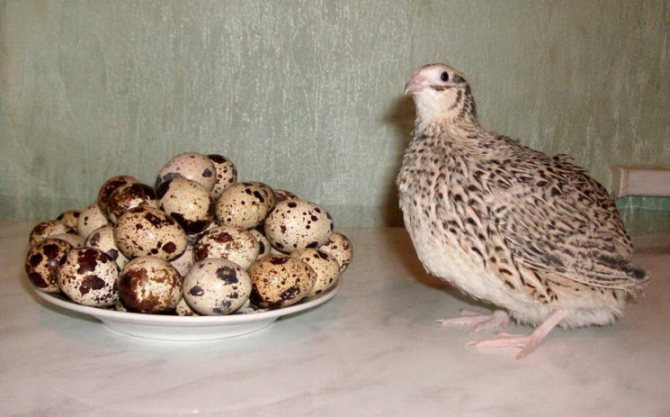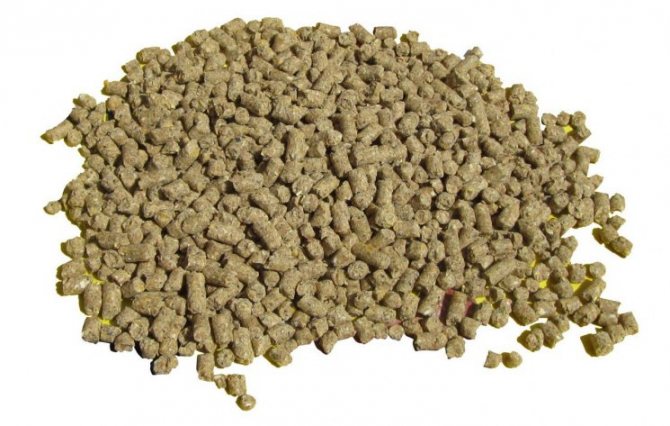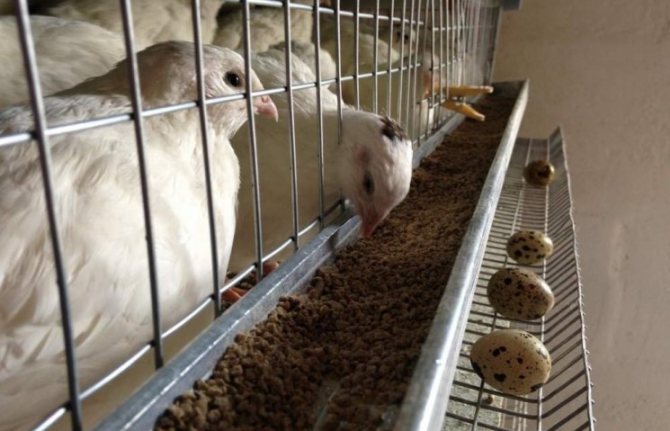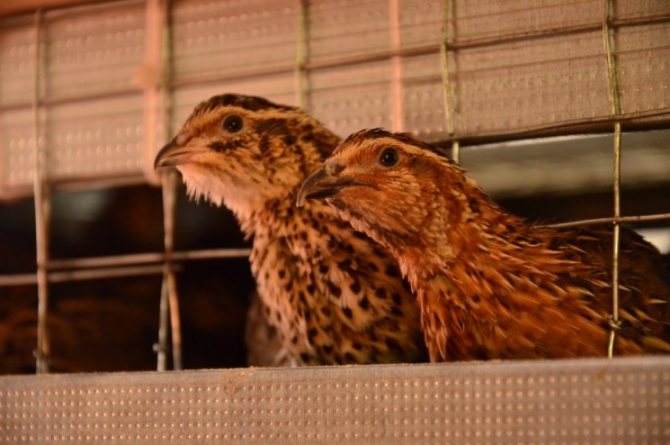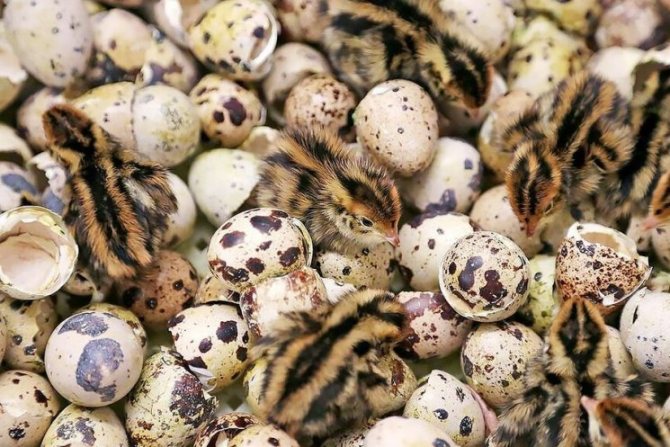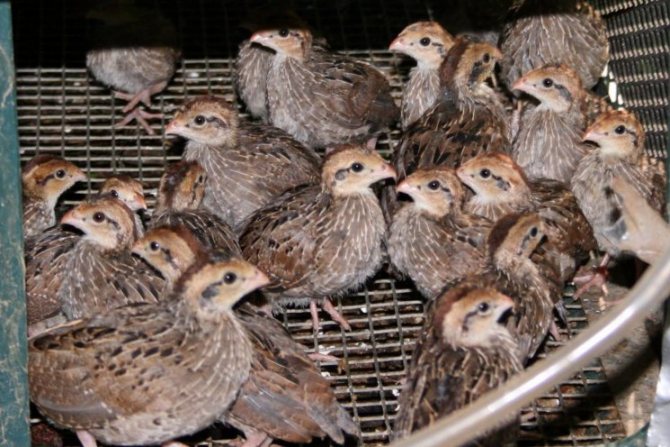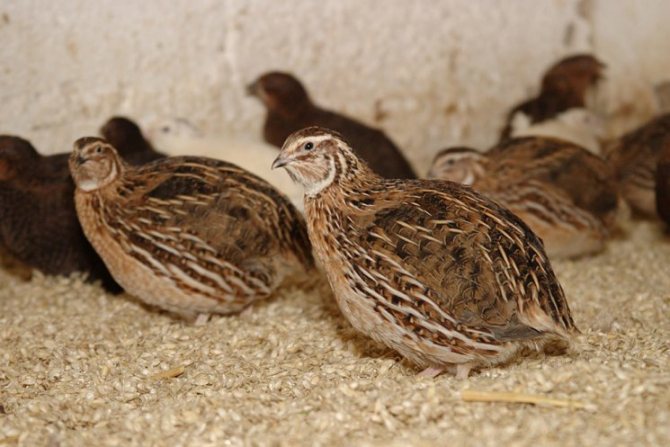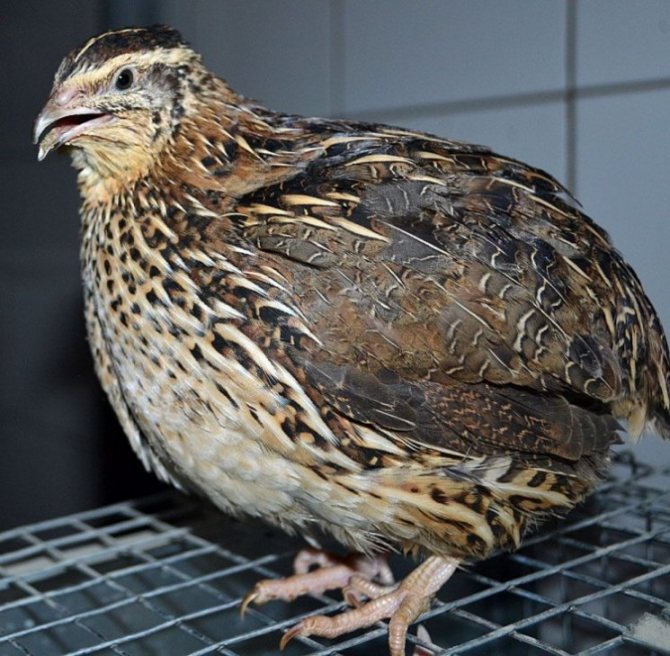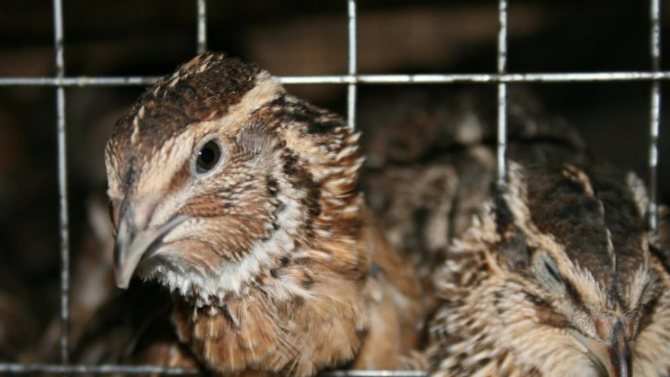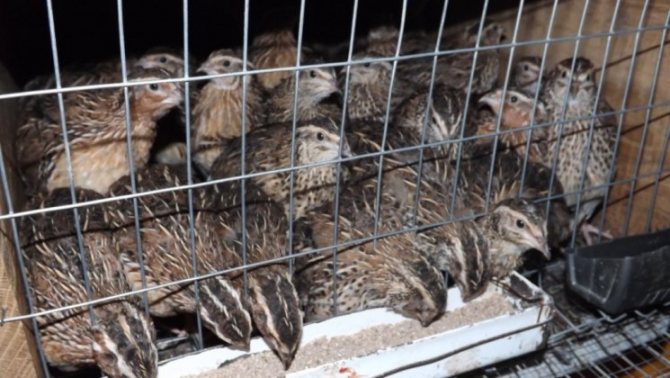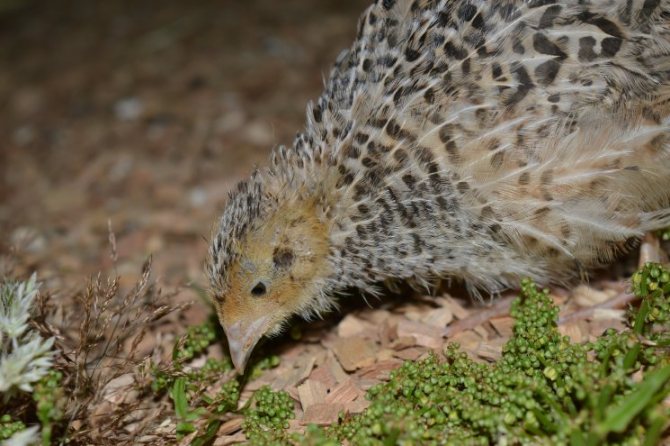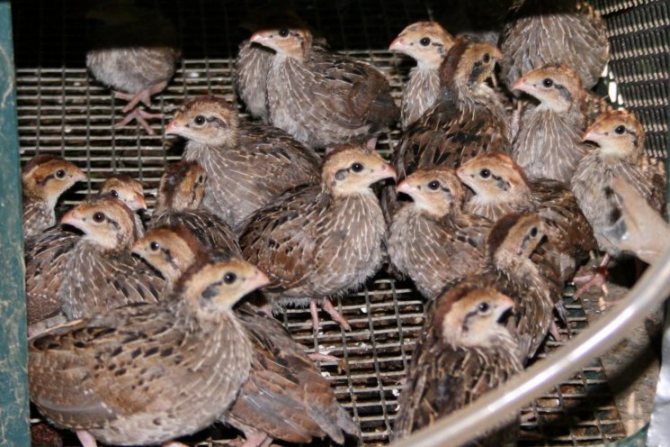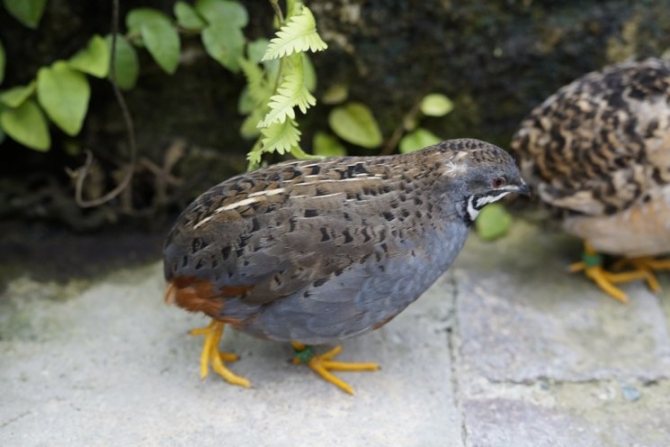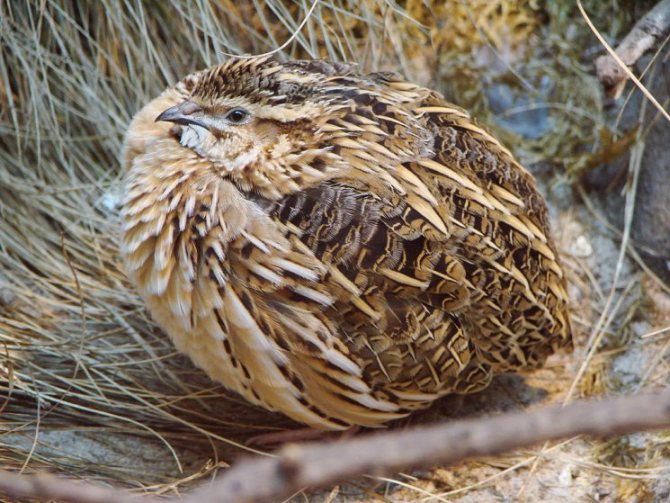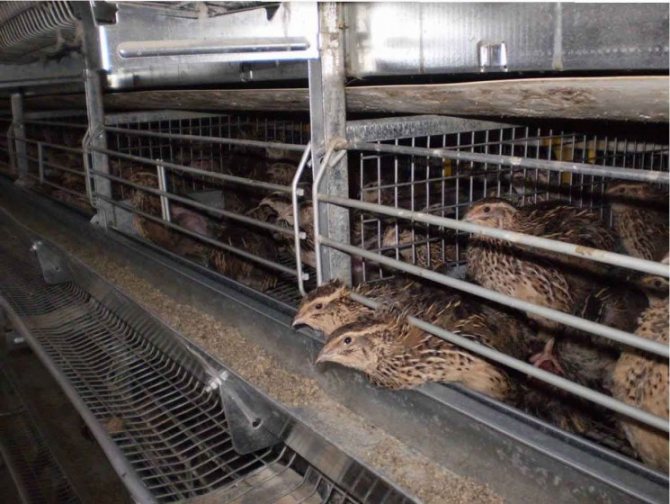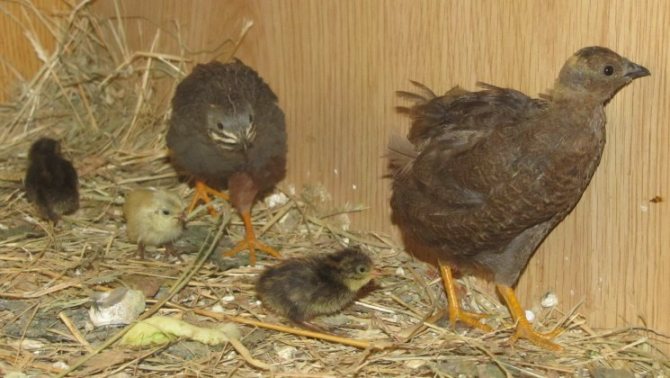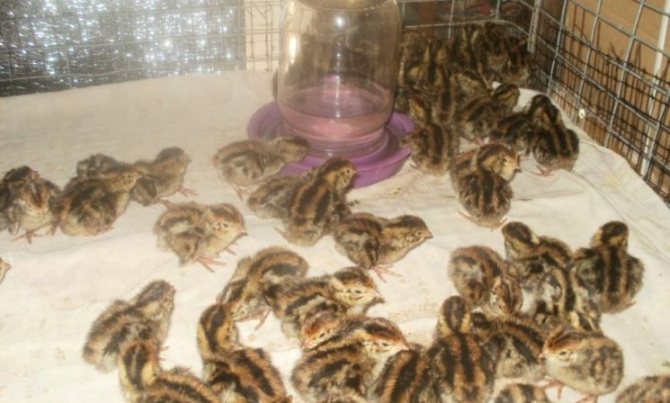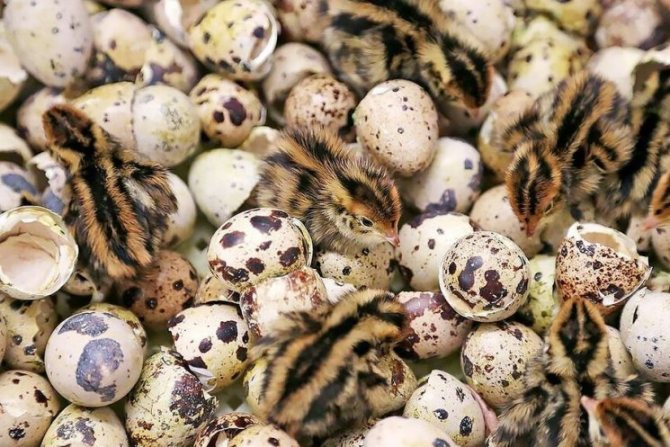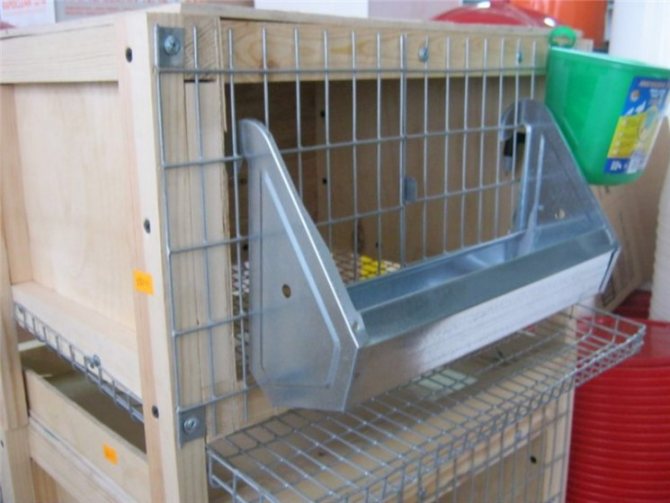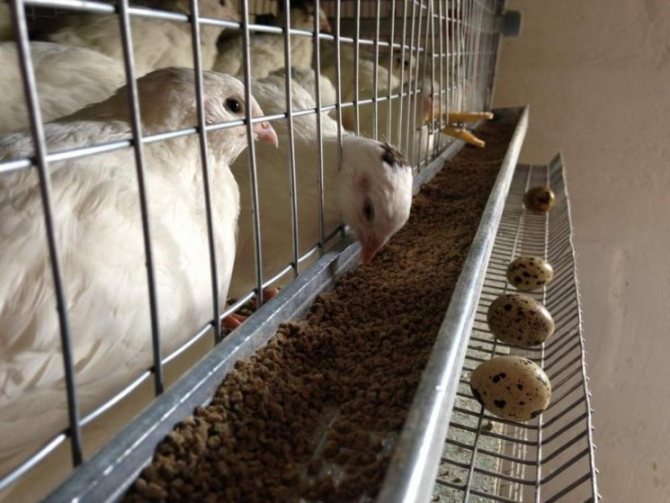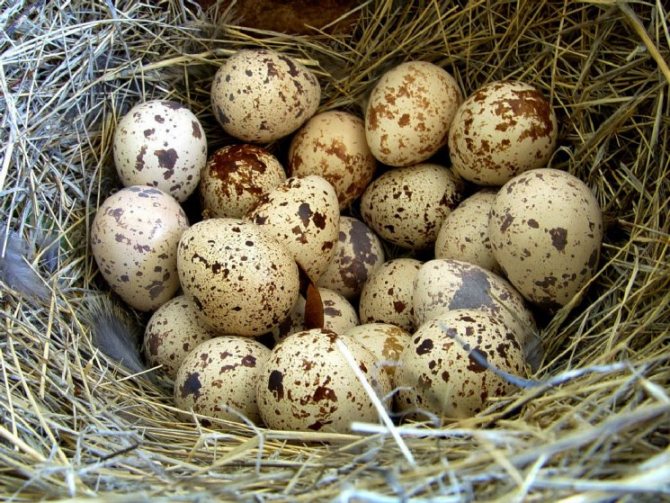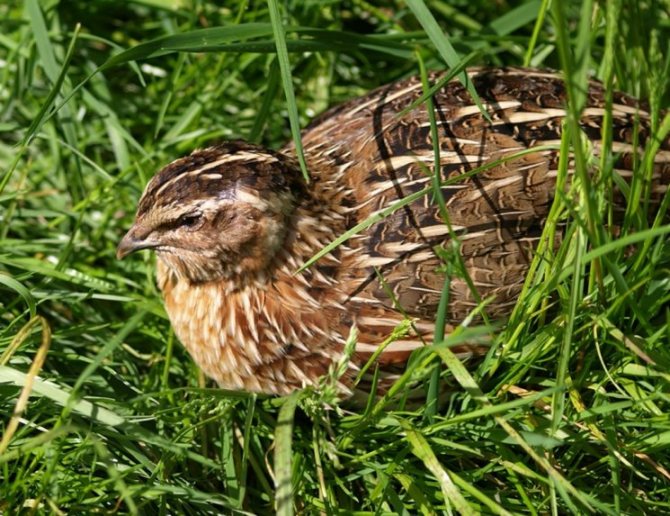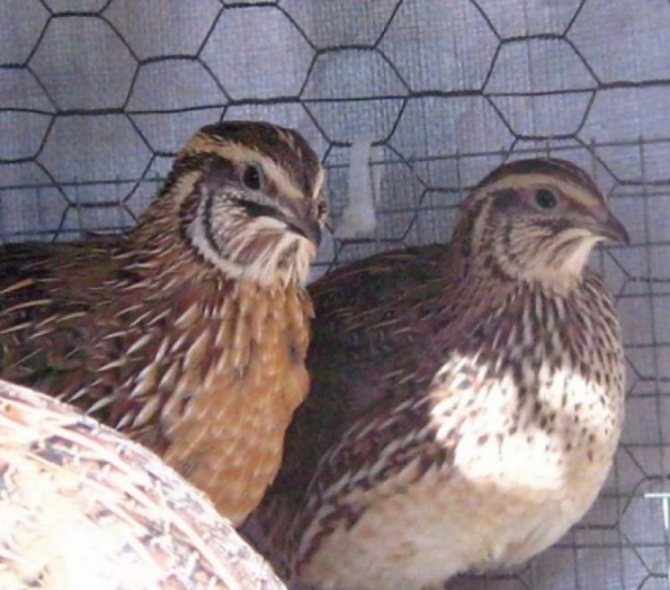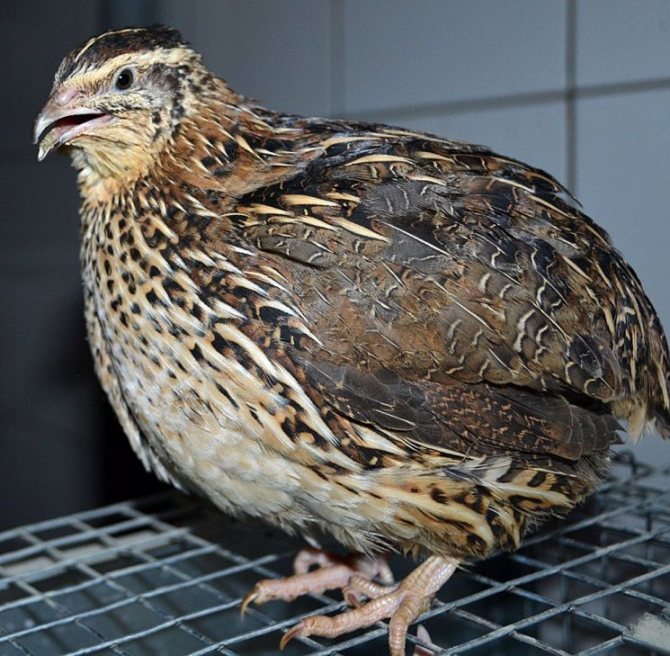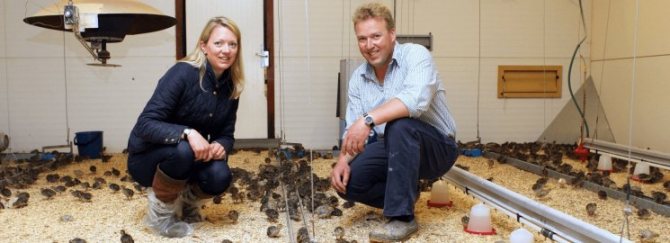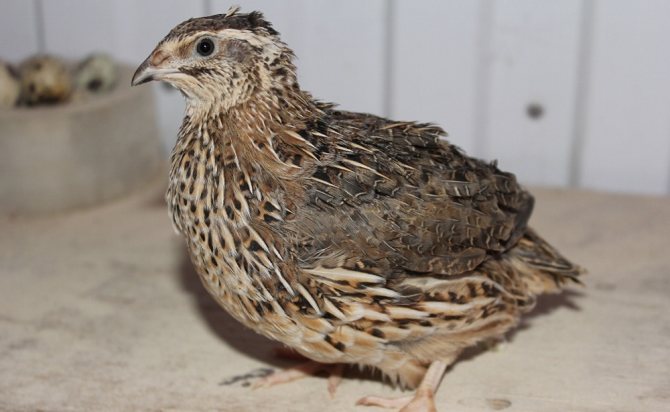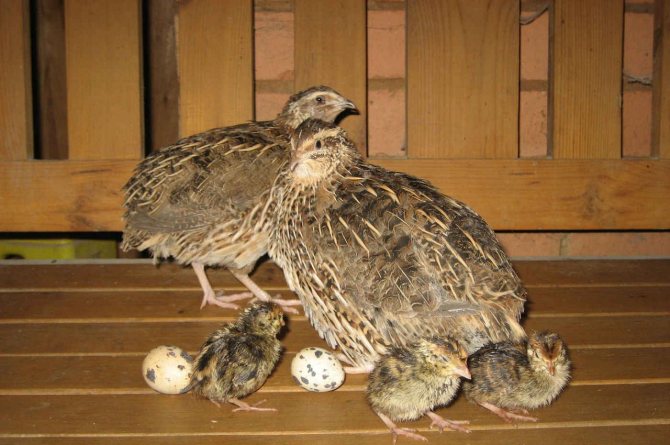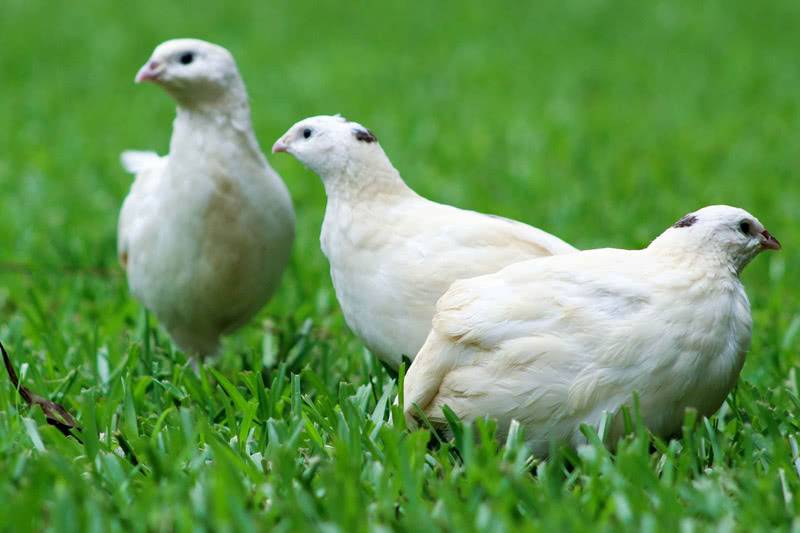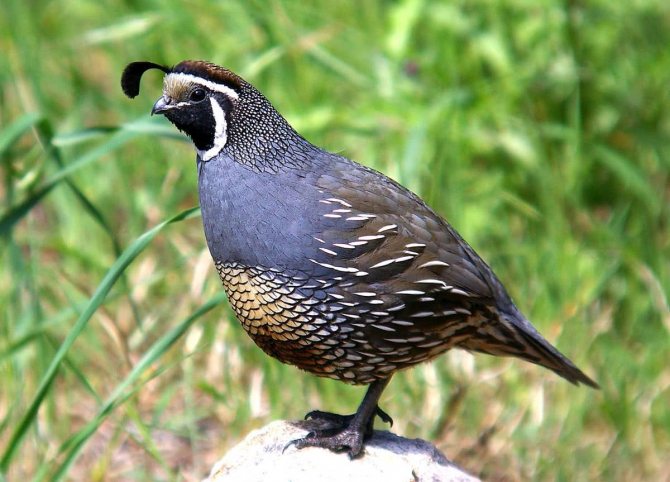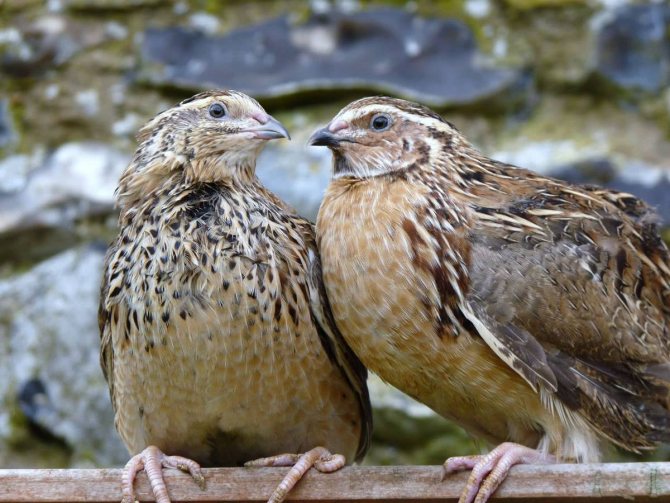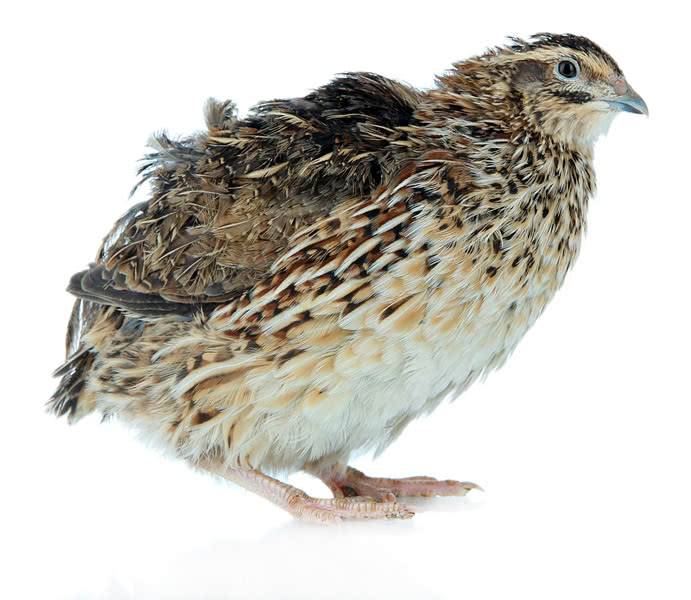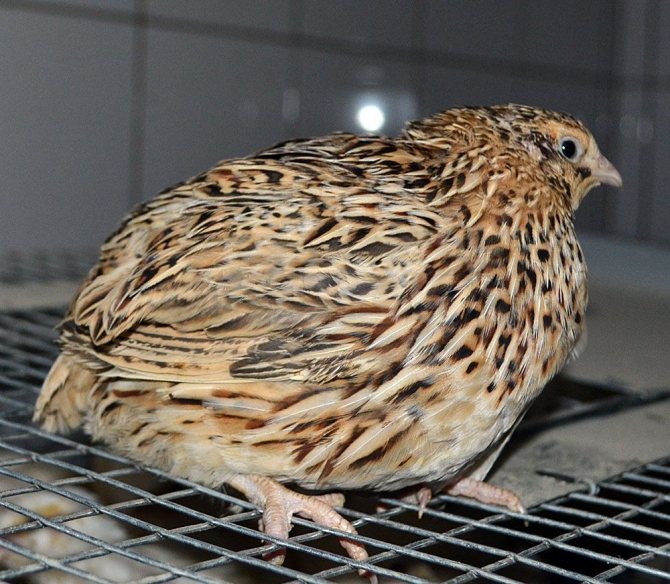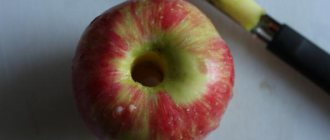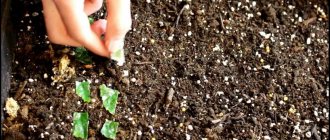Breeding quail at home for beginners may seem like a difficult and even exotic activity. No wonder. Quail farming in our country is not developed on such a large scale as the breeding of chickens, geese, ducks, etc.
The value of quail meat and eggs is mainly known to people who, for one reason or another, adhere to certain diets. And this is certainly not fair. Poultry quails are unpretentious and can be carried almost every day, and meat is much more expensive than chicken and much more nutritious.
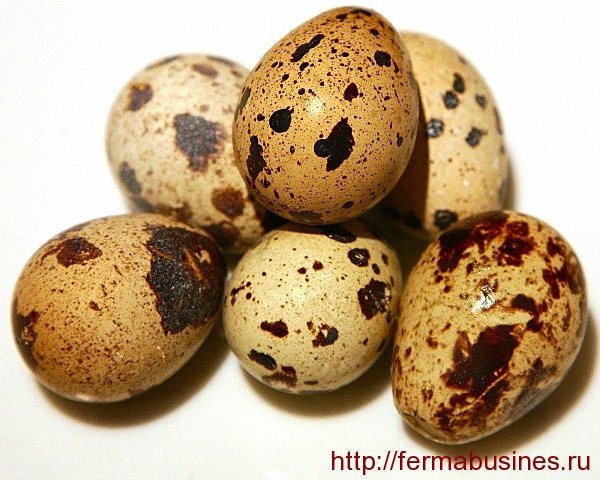
Quail eggs
You can breed quails almost anywhere - in a private house, in the country, and even on the balcony of an ordinary city apartment. Quails do not need large rooms and they do not need to build a large chicken coop with walks. For example, fifty quails can be comfortably placed in a cage with an area of about 1 sq. And under properly organized conditions of keeping (this is done very easily) and care, such a small livestock can lay about 48 eggs (each weighing from 10 to 12 grams) within a day, which is equal to eight hens.
If you are a beginner quail breeder and you have no experience in keeping these birds, then we advise you to decide what is more profitable for you - purchasing adult birds or hatching chickens from eggs in an incubator before acquiring these cute and funny birds.
Organization of conditions of detention
Regardless of where the quails will be kept (barn, apartment, living quarters), the main thing is to ensure the necessary temperature regime.
As a result, before purchasing a bird, give them a place in advance where the air temperature will be in the range of 18-20 degrees.
Temperature jumps above 25 degrees and below 12 can not only adversely affect productivity, but birds will begin to lose plumage (at high temperatures), and at low temperatures, for example -7, they will simply die.
The next condition is a correctly made cell.
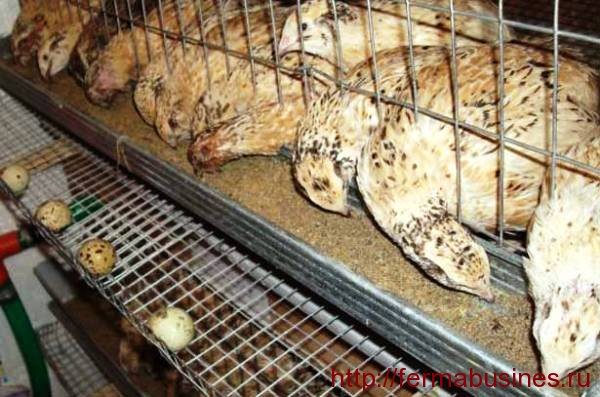

Quail cell content
If you are a beginner quail breeder, then pay special attention to the cages. If you decide to do it yourself, then follow the advice and drawings that are presented in our CELLS section, it offers various options that can be assembled in ordinary home conditions, even without having special skills in this matter. In a store, a quail cage is quite expensive and, accordingly, will pay off for more than one month.
It is also worth noting that cages intended for keeping parrots or other birds are not suitable for quails.
What to look for when buying a quail cage
If you nevertheless decide to purchase a quail cage, then pay attention to the following. It is desirable that the main elements are metal, the walls are made of mesh. Better if galvanized.
It is also worth paying attention to the presence of feeders and drinkers, which should be located on the front wall, this facilitates care and feeding. The net in this place should be such that your wards can freely poke their heads and reach the feed.
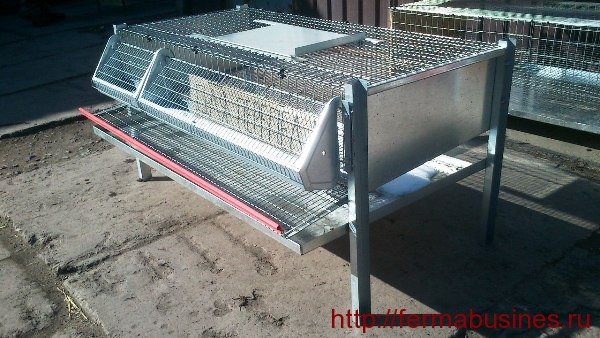

Quail cage
The size of the quail house is also important, its height should be at least 20 centimeters and even a little more.Otherwise, quails with a tendency to jump can injure their heads.
Unlike chickens, which are carried in special nests, quails are not demanding in this and rush to the floor, which should be inclined, and the cage itself is equipped with a special egg receiver.
Also, the quail cage, for easy cleaning, should have a special litter tray behind them, which is located under the mesh floor and should be easily pulled out. If such a tray is not provided, then you run the risk of facing a host of problems, ranging from egg contamination and ending with various diseases of your feathered wards.
Experienced poultry farmers recommend a quail stocking density of no more than 10 goths per 0.2 m. If you do not adhere to these standards, then egg production may decrease.
How to determine the sex of chicks
The sex of the young is determined by color and behavior. In breeds with spotted coloration, the male has a dark “mask” and chest. The breast of females most often has many specks.
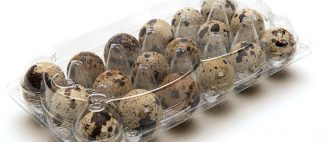

Be sure to read:
The benefits of quail eggs and harm to the human body, how much you can and how to use
Observation will allow determining the sex of day-old chicks. Chickens squeak more often than males.
Quail purchase
If you decide to purchase adult birds, then try to take individuals at the age of 1 to 1.5 months. In a quail female, sexual maturity occurs at the age of 1.5 months and it is at this age that she begins to lay eggs.
Quails should only be purchased from reputable experienced poultry farmers or from farms. Quail, unlike chickens, can be taken regardless of the season, because their egg production is the same all year round.
Pay attention to the fact that when purchasing quails, it will not be superfluous to buy feed from the seller on which the birds were fed. A sudden change in the menu and moving will certainly affect not only their egg production, but in some cases can lead to indigestion. Stock up on feed for about a month, this time will be enough to gradually transfer your wards to the feed that you have.
Feeding for females during egg production
A seven-week-old young quail is capable of laying eggs in full. Typically, the number of eggs that quails lay in a year is from 300 to 320 eggs, which means that she lays 1 egg per day (except for the days when she is moulting). But such an intense egg production will be possible only with a good, balanced diet of birds. So, what are quails fed to make them fly well?
The most optimal way is considered to be feeding with high quality compound feed. Since it is always very rational in its content, it has all the important vitamins.
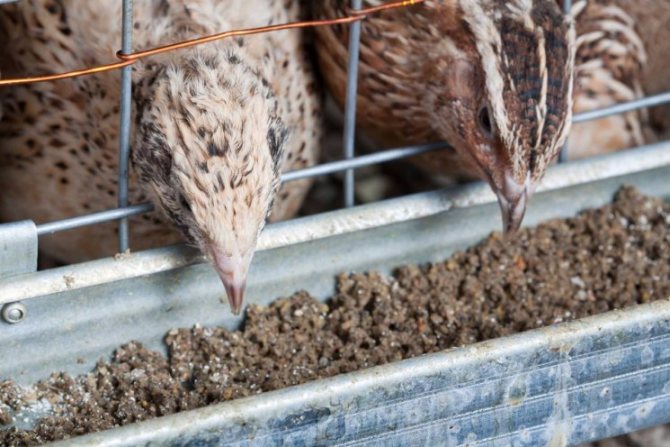

Combined feed is usually poured into a special container once a day in a solid dried form. Compound feed is good because it does not sour, does not even spoil, which greatly simplifies feeding.
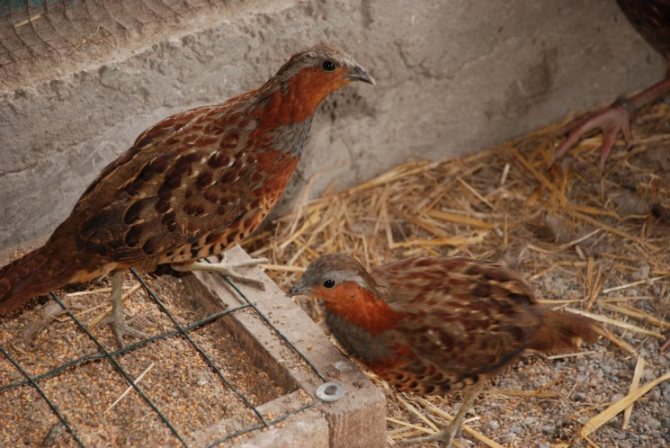

Incubation
If you decide to seriously start breeding quails at home with the subsequent expansion of your farm with the subsequent organization of even a small poultry farm, then you better not spend money on an adult bird, but get an incubator.
Quail eggs are incubated in almost the same way as eggs of any other poultry: chicken, ducks or geese with slight differences in timing, humidity and temperature conditions.


Setting eggs in the incubator
Many quail breeders often complain that in an ordinary incubator, which is designed for about 80-100 chicken eggs, it is difficult to incubate quail eggs. Especially if it is a small batch of up to 80 pieces. This is because the eggs are simply rolled out in the incubator.
And here, there is vanity and unnecessary chores. Many go to extremes. For example, they are starting to make special quail incubators. But the way out is very simple. Quail eggs are simply lined with cotton or cloth around the edges. But it's not that.
In almost all incubators, the temperature deviation from the middle to the edges is at least 0.5 degrees, because of this, the eggs begin to endlessly shift, then to the middle, then to the middle.
But this is unnecessary, do it, as we suggested to you above and this problem will be solved by itself. In addition, in such conditions, the quality and hatchability is significantly increased. In a word, without any hesitation, get a regular incubator and lay eggs in it.
If you have the appropriate skills, you can make a do-it-yourself quail incubator at normal home conditions.
When buying an egg for incubation, the first thing to note is that it must be fresh (no more than seven days old). It is better to purchase from experienced quail breeders or on farms.
In fact, the incubation of quail eggs from chickens is turned off only by timing. If it takes 21 days from laying hen eggs in the incubator to hatching, then the quails are born earlier in 16-17 days. Eggs need to be turned 4-5 times a day.
For the first 10 days, keep the incubator at 38.5 degrees. If the incubator is not equipped with an electronic sensor and thermometer, then the check is carried out using a medical thermometer. In the final seven incubations, it is desirable to lower the temperature to 38 degrees. And on the eve of hatching, about a day before the start of hatching, up to 37.5 degrees.
If we compare with chicken chickens, then the quails are born quite amicably within a maximum of twelve hours. Those that hatch later usually have various deviations and attempts to hatch them are unsuccessful.
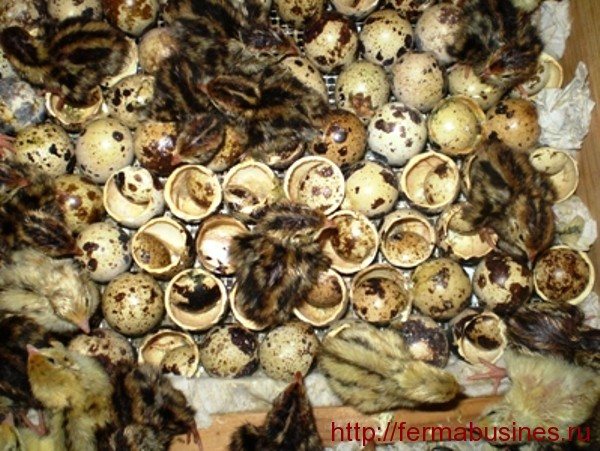

Hatching quail
Breed selection
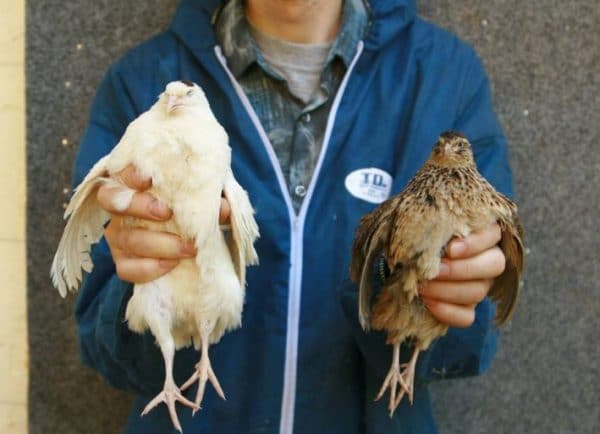

The choice of breed depends on the direction of the economy
The choice of breed depends on the direction of the economy. Quail breeds are divided into meat and egg.
Popular quail breeds:
- Japanese. Has a wild color, individual weight up to 200 g, egg production up to 300 per year.
- White Pharaoh. Broiler breed with pleasant fair skin. Individual weight up to 0.5 kg. Egg production up to 200.
- Estonian. Weight up to 170 grams, female gives up to 280 eggs per year.
- Manchu golden quail. It has an average egg production of up to 230 pieces, weight reaches 270 g. The breed has the largest egg size, females are much larger than males.
- English white. Egg production is up to 290 eggs per year, and the weight of a bird is up to 360 g.
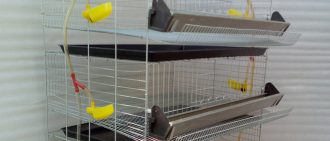

Be sure to read:
DIY quail cage: step by step instructions, types, arrangement
To profit from beef breeds, most of the eggs laid are sent to the incubator, so males and females are kept together. Egg breeds are rarely slaughtered due to their long lifespan.
Growing quail
Growing these birds is more profitable and, most importantly, takes less time than growing the same chickens. And caring for them is even easier. For example, for a chicken to turn into a chicken, it should take about six to seven months, but the Japanese quail breed fully matures and begins to lay eggs after six weeks.
In order for quail breeding at home to be profitable and successful, it is necessary for small quails to create proper conditions from the first days of life.
The brooder into which the young growth from the incubator will be transplanted must be prepared in advance. For this, various wooden or even cardboard boxes may be suitable. Quails are distinguished by a lively character, so a net should be stretched on top of the box. However, it is better to make a special brooder in which it would be possible to create all the necessary conditions for the successful growth of chickens and in which it will be convenient to care for them.
Immediately after hatching, the chicks should be kept at a temperature of about 34 degrees. Then it needs to be gradually reduced and brought to 25 degrees within a month.
Lighting should be around the clock for two weeks. Then it needs to be reduced to 17 hours, but not less. Otherwise, a decrease in egg production is noticed.
Fattening and slaughter
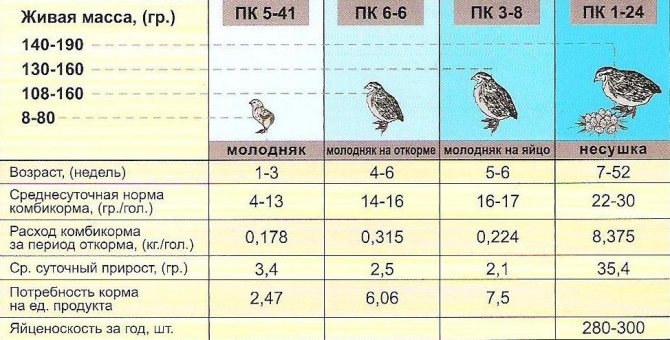

Quail feeding scheme
The conditions for keeping birds intended for slaughter are slightly different from those described. A lower temperature is needed here - 20-24 ° C and dim lighting.
Birds need to be fed four times a day, of which two times with grain, and twice with fatty feed mixed with corn.
When the bird reaches a weight of 120 g, it is already considered ready for slaughter (but depending on the breed, a much higher figure can be achieved). Feeding usually lasts about two months. Birds can only be given water for six hours before slaughter.
For slaughter, it is better to use a kitchen hatchet with a sharpened blade.
Methodology:
- Cut off your head.
- Wait for all the blood to drain.
Use sharp scissors to cut off:
- legs at shin level;
- wings - up to the second joint.
Holding the quail carcass upside down, tear the skin with your fingers and remove it along with the feathers.
Open the carcass with a knife and gut.
Feeding the young
Young quails are fed, in almost the same way as chickens. But there is also a difference in the design of the feeders and drinkers.
Any containers with low edges can serve as feeders. Drinking bowls need to be treated more carefully. Use only vacuum ones, otherwise small chicks in deep drinkers may simply drown.
Hard-boiled eggs are given as the first feed.
Later, the young are transferred to compound feed for broiler chickens.
In order not to engage in resettlement all the time, they will quail. which grow very quickly from one bunker to another at two weeks of age, place them immediately in the cages for an adult bird. And to make it easier to maintain the optimal temperature in them, simply sheathe them, for example, with sheets of cellular polycarbonate or other material, but just do not forget to make ventilation holes in them.
Breeding benefits
As a beef breed, small birds are of little value. The main benefits of breeding them are:
- The diverse composition of the product - protein and microelements with protective functions.
- The content in the egg is twice as much nutrients as compared to chicken.
- Not greasy, dietary product endowed with excellent taste.
- The constant use of eggs improves the condition of bone tissue, has a positive effect on the functioning of the heart, liver, kidneys and pancreas.
- Normalization of the function of the gastrointestinal tract, which is why they treat children prone to allergic reactions.
- Possible eating of eggs without heat treatment due to the absence of salmonellosis infection.
Content
Keeping quails at home implies proper feeding and organization of correct lighting and maintaining the correct temperature regime. We talked about light and temperature earlier, now let's talk about feeding these birds.
First of all, you need to know that a quail eats on average about thirty grams of feed per day, i.e. during the year about 10 kilograms. For a year, she can lay up to 3 hundred eggs weighing 3-3.2 kilograms. A laying hen, for the same period, can eat about 50 kilograms of compound feed and lay up to 180 eggs, weighing about 10-11 kilograms.
What do laying quails eat if there is no compound feed?
If there is no compound feed, then the owner of the birds will have to prepare the mixture himself to feed the birds. Adult layers are fed with a mixture containing 20-22% protein per 100 grams.
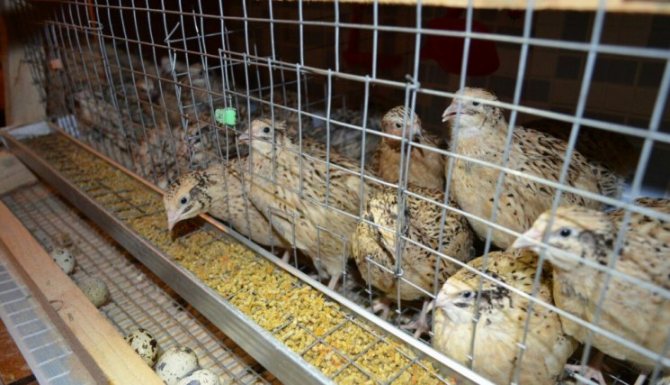

Here is an approximate composition that is used for carrier quails:
- Crushed grain (corn, wheat, pea grains, etc.) - 50%;
- Oilcakes from sunflower - 20-25%;
- Curd product, game, fry (or flour powder from them) - 7-8%;
- Yeast for feed - 4-6%;
- Grass flour - 5%;
- Limestone, sea crushed shell, crushed shell - 6%;
- Sulfate - 2/10%.
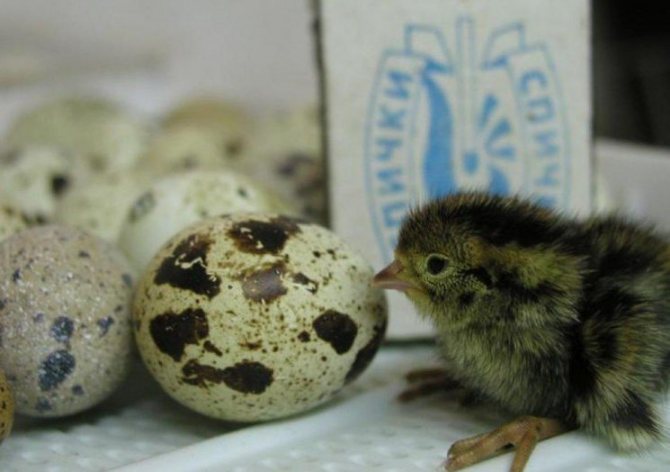

Preference should be given to such types of grains as corn, peas, cereal wheat, since they are the most nutritious, best absorbed from all other types of cereals.
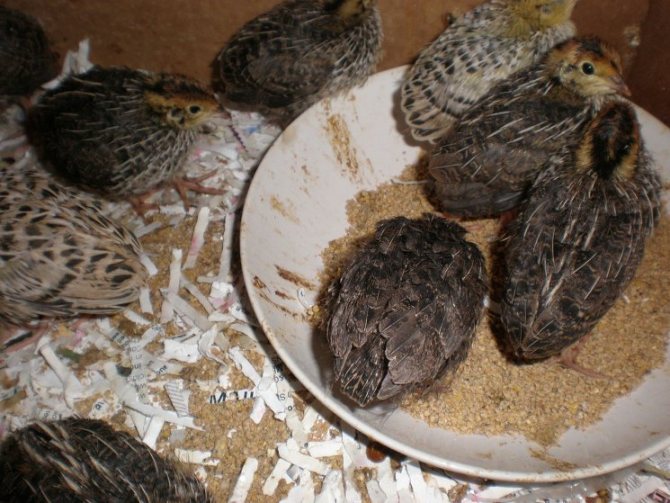

Be sure to add a nutritional complex of vitamins and minerals to your self-prepared food in order to enrich it with all the necessary minerals.
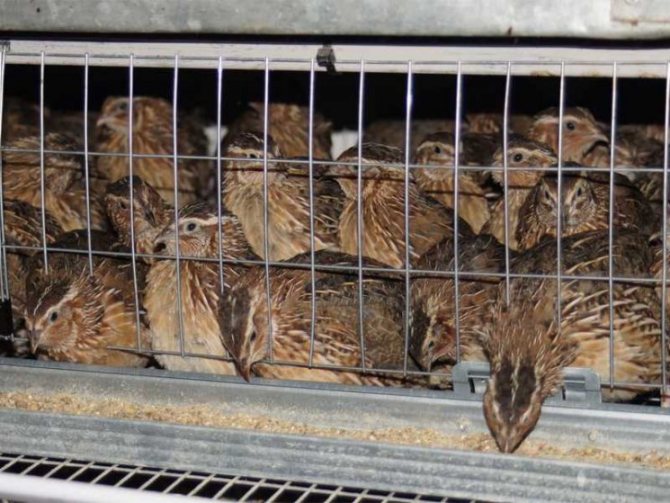

Quail feeding
At first glance, there is no difference in feeding overfishing and chickens. It would seem that 4 quails can eat the same amount of feed as one chicken. Remove approximately the same egg mass. But this is a delusion. The difference is in content and productivity. For example, a cage containing fifty quails, which can easily replace 10 chickens, can be placed even in the smallest household or even in an apartment. This cannot be said about chickens. But it is advisable to feed them with compound feeds that are made at the factory.
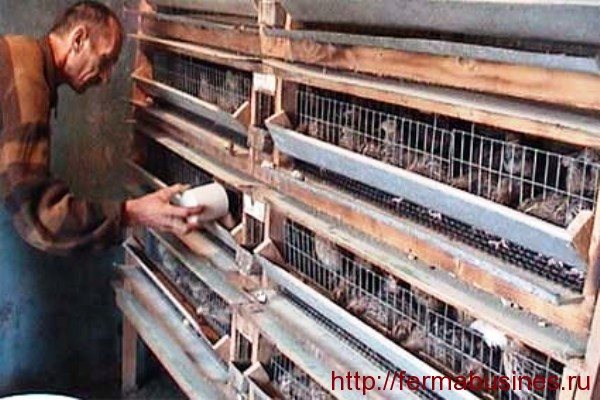

Cage feeding
But there is one problem here - compound feed is not produced especially for laying quails. If you see compound feed for quails somewhere on the market, then this is a deception.
Therefore, many quail breeders recommend immediately giving starting compound feed for broiler chickens of the PK - 5-2 brand. In particular, this compound feed has the required proportion of highly digestible protein, which this species of birds needs for good egg production.
You need to feed adults 3 times a day, while the feed rate must be strictly observed. It is different for different breeds, but ranges from - 25 to 30 grams per day.
If you give more or less feed, this will negatively affect egg production. Do not forget that the feeders must be located on the front of the cage, and the drinkers must be drip.
These are perhaps all the basic recommendations for breeding and caring for quails at home for beginners. If you are an experienced quail breeder and have your own experience, please share it with your novice colleagues by leaving a comment below. And we and the readers, of course, would like to receive as much information as possible.
Chick care
Newly born quail chicks should be covered with brownish fluff with two light stripes on the back. Healthy chicks weigh from six to eight grams, they are active from the very first hours. The babies need to be carefully monitored at first, since the chicken is capable of:
- huddle in some gap and suffocate;
- get into a saucer of water and choke.
After the chicks are dry, they are transferred to another place - a brooder. This is the name of a separate cage specially designed for raising chicks. Its size is selected according to the number of young animals contained in it. However, instead of a cage, you can also use a space enclosed by a grid.
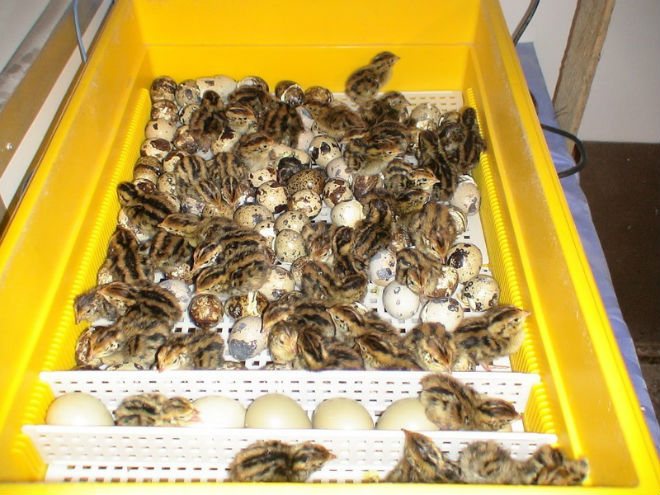

After hatching chicks in the incubator, you must wait until they dry out.
As for caring for chicks, everything is simple. The kids eat themselves, but you will need to:
- timely feeding. The diet should include enough protein to help babies grow faster. In the first days, they need to be fed five times a day with a boiled finely chopped egg. On the fourth day, cottage cheese and compound feed are introduced, specially designed for young animals, but passed through a coffee grinder. By the end of the first week, you can already add finely chopped greens to your food. When babies are 21 days old, they are switched to adult food. If you follow the diet correctly, in the first two months the chicks should increase their weight 20 times;
- water supply.Since there is always a risk of drowning, chicks need to be poured into special drinkers - vacuum or nipple. Water is required necessarily boiled and warm. From time to time you need to water the kids with Levomycetin solution;
- compliance with the temperature regime. If the quails are uncomfortable, they will begin to behave accordingly. When it is hot for them, the chicks disperse along the edges of the room and stand with their beaks open; if it is cold, they huddle together and squeak.
Adjust the heat by raising or lowering the lamp. The temperature in the brooder is maintained:
- in the first week: within 35 - 38 degrees;
- in the second week, they are lowered to 34 degrees;
- on the third - up to 30;
- by the end of the fourth week, they are reduced to 22 degrees.
As for the brooder himself, he:
- must have ventilation;
- the length of daylight hours in the first two weeks is set at 24 hours, later reduced to 17.
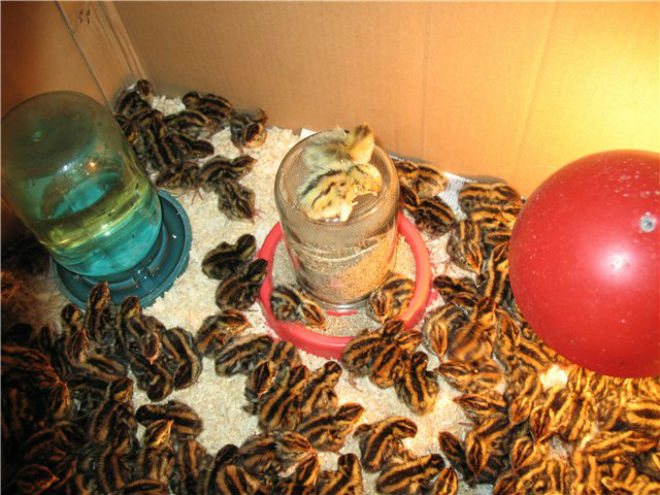

A separate cage specially designed for raising chicks is called a brooder.
Ripening period
Sexual signs will begin to appear in the fourth week:
- "Boys" acquire a reddish-brown (speckled) color of the neck and breast;
- "Girls" - light gray, also speckled.
By the beginning of the third month, the males stop growing, on the 40th day they are ready to mate. Females will need at least nine weeks for the maturation stage to be fully completed.
During this period, the flock is sorted out - females are rejected, males are selected, if it is supposed to grow quails for meat in the future. Those and others are seated in different cages for fattening.

